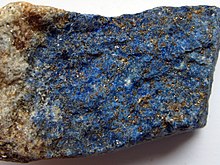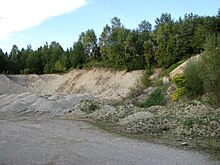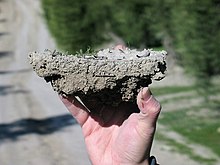


In the Earth sciences, aggregate has three possible meanings.
In mineralogy and petrology, an aggregate is a mass of mineral crystals, mineraloid particles or rock particles.[1][2] Examples are dolomite, which is an aggregate of crystals of the mineral dolomite,[3] and rock gypsum, an aggregate of crystals of the mineral gypsum.[4] Lapis lazuli is a type of rock composed of an aggregate of crystals of many minerals including lazurite, pyrite, phlogopite, calcite, potassium feldspar, wollastonite and some sodalite group minerals.[5]
In the construction industry, an aggregate (often referred to as a construction aggregate) is sand, gravel or crushed rock that has been mined or quarried for use as a building material.
In pedology, an aggregate is a mass of soil particles. If the aggregate has formed naturally, it can be called a ped; if formed artificially, it can be called a clod.[6]
Construction aggregate examples[edit]
Use in industry[edit]
Aggregates are used extensively in the construction industry[9][10] Often in making concrete, a construction aggregate is used,[4] with about 6 billion tons of concrete produced per year.[11]
See also[edit]
References[edit]
- ^ Neuendorf, K.K.E.; Mehl, J.P. Jr.; Jackson, J.A., eds. (2005). Glossary of Geology (5th ed.). Alexandria, Virginia: American Geological Institute. p. 11.
- ^ Abel, Mara; Lorenzatti, Alexandre; Rama Fiorini, Sandro; Carbonera, Joel (2015). Ontological analysis of the lithology data in PPDM well core model. PNEC Conferences. Houston. p. 3. Retrieved 27 March 2017.
- ^ Teichert, Curt (1965). Devonian Rocks and Paleogeography of Arizona (US Geological Survey Professional Paper 464) (PDF). Washington DC: USGS. p. 150.
- ^ a b Jessica Elzea Kogel (2006). Industrial Minerals & Rocks: Commodities, Markets, and Uses (7th ed.). SME. p. 522. ISBN 978-0-87335-233-8.
- ^ T. Calligaro; Y. Coquinot; L. Pichon; B. Moignard (2011). "Advances in elemental imaging of rocks using the AGLAE external microbeam". Nuclear Instruments and Methods in Physics Research B. 269 (20): 2364–2372. Bibcode:2011NIMPB.269.2364C. doi:10.1016/j.nimb.2011.02.074.
- ^ Allaby, Ailsa; Allaby, Michael (1999). A Dictionary of Earth Sciences (2nd ed.). Oxford: Oxford University Press. ISBN 0-19-280079-5.
- ^ Same Day Aggregates: Types of Aggregates - Same Day Aggregates, accessdate: March 25, 2017
- ^ Indiana Mineral Aggregates Association | Carmel, IN: What are aggregates? - Indiana Mineral Aggregates Association | Carmel, IN, accessdate: March 25, 2017
- ^ Introduction (1): What are Aggregates? « Herefordshire & Worcestershire Earth Heritage Trust: Introduction (1): What are Aggregates? « Herefordshire & Worcestershire Earth Heritage Trust Archived 2019-02-09 at the Wayback Machine, accessdate: March 23, 2017
- ^ Define Aggregate at Dictionary.com: aggregate, accessdate: March 23, 2017
- ^ Qasrawi, Hisham; Marie, Iqbal (2013). "Towards Better Understanding of Concrete Containing Recycled Concrete Aggregate". Advances in Materials Science and Engineering. 2013: 1–8. doi:10.1155/2013/636034.
External links[edit]
- What are aggregates? Archived 2019-02-09 at the Wayback Machine
- Concrete Aggregates — Geological Considerations
- What is aggregate? — The Bare Essentials of Concrete — Part 2 YouTube video (duration 4 minutes)